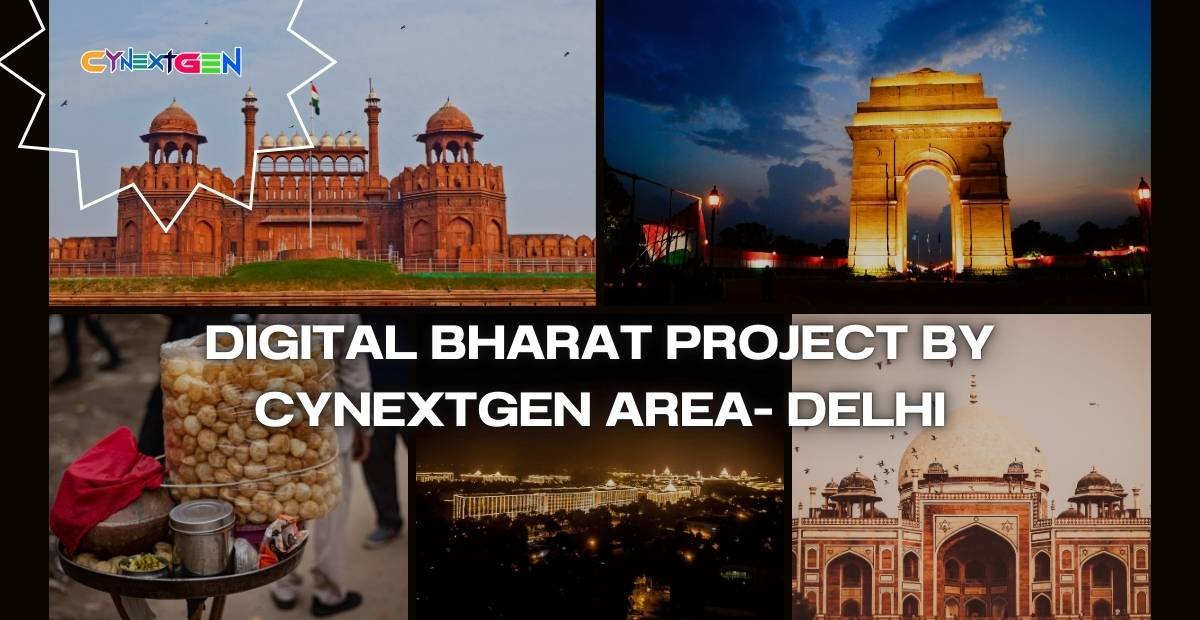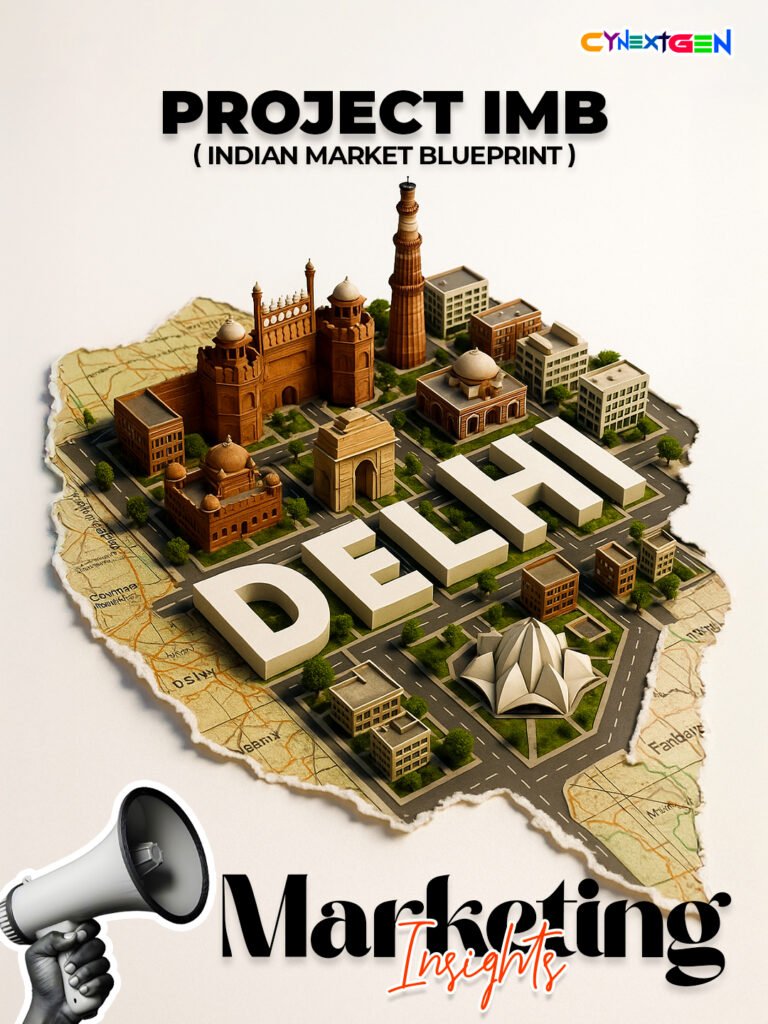
DIGITAL BHARAT PROJECT BY CYNEXTGEN AREA- DELHI
Delhi has always been more than just India’s capital; it is a city where cultures meet commerce, and where digital adoption shapes how millions consume, shop, and interact. Under the DIGITAL BHARAT Project by Cynextgen, Delhi emerges as one of the strongest urban hubs driving the next phase of India’s digital and consumer growth.
Demographic Snapshot of Delhi
Delhi’s population in 2024 is estimated at 20.7 million. With 11.1 million males and 9.6 million females, the city reflects a balanced consumer base. But what makes Delhi unique is not just its size, it’s the digital penetration. Nearly 80% of its population is online, making it one of the most digitally active regions in the country. Mobile dominates with 80–85% of internet access, while desktop usage continues to shrink.
This digital-first behavior has made Delhi the testing ground for new e-commerce models, quick commerce services, and influencer-driven marketing campaigns.
Social Media and Digital Behavior
Delhi’s internet users are not passive; they’re deeply engaged. Platforms like Facebook and LinkedIn remain strong among working professionals, while YouTube and Instagram dominate youth culture with entertainment, learning, and lifestyle-driven content. WhatsApp has become a default communication tool, and Snapchat’s growth among Gen Z points to the city’s youthful appetite for visual, fast-paced interaction.
For brands, this means Cynextgen’s strategy of tapping into hyperlocal influencers, micro-communities, and real-time engagement becomes vital.
Why is Delhi Famous as a Consumer Market?
Delhi is often called the FMCG capital of India. A household in West Delhi spends an average of ₹39,325 annually more than double the national average. South Delhi, on the other hand, leads in volume, consuming nearly 240 kg of FMCG products annually.
This spending power is shaped by preferences: bottled drinks, packaged snacks, sauces, spices, and larger pack sizes dominate. The trend clearly shows Delhi consumers value taste, hygiene, and convenience. For modern brands, it’s a chance to bundle experience with affordability, whether through premium sauces in South Delhi or larger snack packs in West Delhi.

High-Growth Market Segments
Delhi’s consumer growth is not limited to traditional FMCG. The city is experiencing:
Quick-Commerce Boom
Apps like Blinkit, Zepto, and Instamart are part of daily life in Delhi households. From ready-to-eat meals to late-night snack runs, quick commerce is not just a trend it’s a necessity.
Home & Personal Care + Wellness
The Home & Personal Care category grew by nearly 6% in early 2025, while over-the-counter health products surged by 14%. Hygiene, transparency in ingredients, and wellness packaging are shaping buying choices.
Premium and Private-Label Brands
Affluent households in South and West Delhi prefer premium packaged foods, spices, and beverages. Private-label products, with their affordability and variety, are also gaining traction.
Spending Power of Delhi’s Youth
Delhi’s youth especially Gen Z and Millennials are spending 110% more than the average consumer on food, beverages, fashion, and entertainment. They seek experiences, not just products.
Events like Delhi’s college fests draw thousands of students, making these gatherings powerful hotspots for brand activations. Cynextgen actively works with college circuits, using micro-influencers and event sponsorships to give brands cultural relevance.
Growth Drivers for the Future
EV and Urban Mobility
Delhi is pushing toward EV adoption, particularly two-wheelers and compact cars. However, infrastructure readiness will decide the pace of growth.
Sustainability and Eco-Friendly Products
Affluent areas are increasingly demanding eco-friendly packaging, transparent personal care products, and healthier food alternatives.
Hyperlocal Brands
Small Delhi-born brands, whether offering tangy sauces or traditional snacks, are growing faster than national labels because they understand local tastes and digital-first sales tactics.
Consumer-Capturing Strategies
To win Delhi’s consumer base, brands must follow a hybrid playbook:
- Target the youth with quick commerce launches and influencer tie-ins across Instagram and YouTube.
- Focus on affluent clusters like West and South Delhi, offering premium packs and lifestyle positioning.
- Blend offline and online sales channels, making sure kirana shops and e-commerce both feature the brand.
This is where Cynextgen brings its strength bridging hyperlocal activation with national growth strategies, ensuring every brand captures both Delhi’s households and its youth-driven cultural pulse.
Case Studies: Lessons from Delhi
Success: Mother Dairy / Safal
Mother Dairy became a household name by deeply understanding Delhi’s consumer psyche. With over 1,500 booths across the city, it ensured accessibility and hygiene, two factors Delhiites value highly. Safal, its retail extension, capitalized on seasonal products and dairy variants customized for Delhi’s taste.
Failure: Ghantewala Halwai
On the other hand, Ghantewala, a 200-year-old sweet brand, collapsed because it did not modernize. Lack of hygienic packaging, outdated retail formats, and regulatory challenges made it irrelevant in a city that increasingly demanded convenience and branded experiences.
Delhi’s Famous Places and Market Culture
Delhi’s markets mirror its diversity. From Chandni Chowk’s traditional bazaars to Saket’s modern malls, the consumer journey spans heritage and modernity. Tourists flock to iconic spots like India Gate, Lotus Temple, and Qutub Minar, but beyond sightseeing, these visits also drive sales of packaged snacks, cultural souvenirs, and bottled beverages.
Neighborhoods like South Delhi’s Hauz Khas are hubs of premium cafés and lifestyle consumption, while Karol Bagh and Connaught Place represent middle-class and mass-market vibrancy.
The Road Ahead with Cynextgen
The DIGITALBHARAT Project highlights Delhi’s role as India’s digital consumption powerhouse. The city’s youth, its affluent clusters, and its digital-first mindset make it a prime territory for brand growth.
For businesses, the challenge lies in blending tradition with modernity offering authentic experiences while matching global standards of convenience and packaging. That’s where Cynextgen steps in crafting strategies that balance data with culture, ensuring every brand thrives in Delhi’s evolving digital marketplace.
Delhi is not just India’s capital it’s a blueprint for how digital adoption and consumer power can reshape markets. With the DIGITALBHARAT Project by Cynextgen, brands have the roadmap they need to capture one of India’s most dynamic markets.




Add Comment